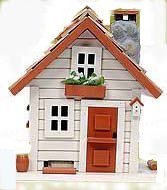| |
Metal Replacement Windows
Types of
Metal Windows
Metal
windows, both steel and aluminum, like other types, have their
advantages and
disadvantages. Metal windows are mostly used by commercial customers.
They are strong and as such offer good
durability and longevity at a reasonable cost. This combined with their
narrow profile is why many architects like
them. Lets start with steel windows.
Steel Windows
While steel windows offer some
aesthetic appeal, and long-term life
expectancy, they do have some major drawbacks. Steel has high thermal
conductivity, which means touching the
windows on a cold winter day can be unpleasant. Metal windows are long
lived but are subject to corrosion, warping
and drafts. Remember the conductivity of a wood window is 1.2, and the
lower the number the better. The government
rates steel windows at about 350! The other problem with all metal
windows is that metal against metal doesn't seal
real well... they're drafty. The major styles of steel windows are
steel casements and double hung
windows.
So the major
plus for steel windows is strength and therefore longevity. Over the
long term this could also produce some savings. The problem with their
savings is they give them back in terms of
fuel loss. Steel is a high conductor of heat and cold. They will get as
cold or hot inside as they are outside. Not
good in today's world of high-energy costs.
Okay enough of
steel windows, lets take a look at aluminum windows
Aluminum Windows
Aluminum windows have much in
common with steel windows. They last a
long time because they are strong. Not as strong as steel windows, but
strong. As a metal window they are also
drafty. They come in double hung style, but vastly more popular in
aluminum windows is the aluminum slider. Some
brands may call it a glider.
Like their steel cousins they were
popular about 50 years ago when
oil was $.17 per gallon. They were popular because they were strong and
cheap and fuel efficiency was not really an
issue. When it comes to conductivity, remember wood was 1.2, steel
about 350, and aluminum is ...fasten your seat
belt, 1,500. Wow! Is it any wonder why they put beer and soda in
aluminum cans, it gets cold fast. I've been in
many homes over the years with aluminum windows with frost and ice on
the inside. You see metal windows sweat, and
then the condensation freezes. This is also why metal windows many
times get mold and mildew. One thing to watch
out for is the "thermal break". The theory is that the inside of the
sandwich will not pick up the cold or heat
from the outside because of the thermal break. It doesn't really work;
it just slows the process down a bit. The
truth is that it is not a thermal break; rather it is a thermal barrier.
So much for metal windows, move on
to composite windows.
|
|
Main
About Us
Privacy
Contact Us
Sitemap
|
|
|

